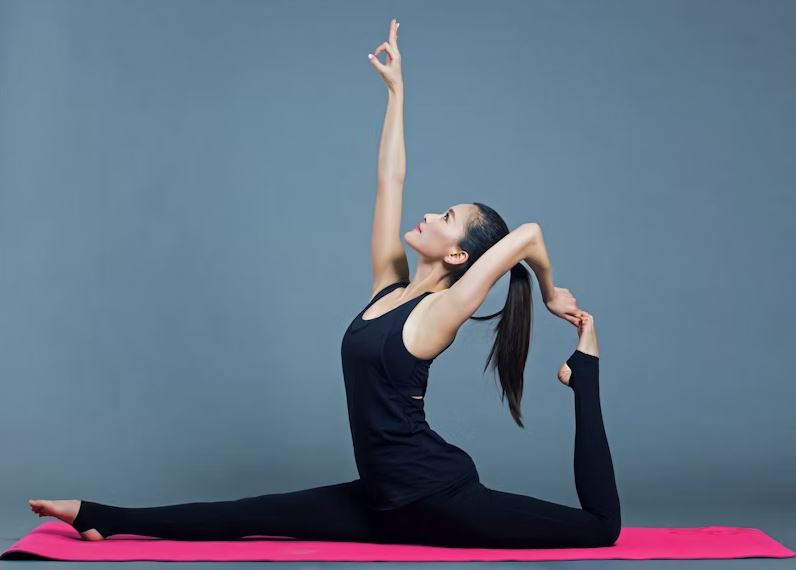Starting a yoga journey can feel exciting but also a little overwhelming. With hundreds of poses practiced across different styles, it’s easy to wonder where to begin. The good news is that you don’t need to master advanced postures to experience the benefits of yoga. A handful of foundational poses are enough to build strength, flexibility, and confidence on the mat.
In this guide, we’ll walk through essential yoga poses every beginner should learn, why they matter, and how to practice them safely.
1. Mountain Pose (Tadasana)
Why it matters: Often called the “blueprint” for other standing poses, Mountain Pose teaches alignment, balance, and body awareness.
How to practice:
- Stand tall with feet hip-width apart.
- Press evenly through your feet.
- Engage your thighs and lift your chest.
- Relax shoulders and keep arms by your sides.
- Breathe deeply and hold for 30 seconds.
2. Downward-Facing Dog (Adho Mukha Svanasana)
Why it matters: This classic pose stretches the entire body while building strength in the arms and shoulders.
How to practice:
- Start on hands and knees.
- Tuck toes under and lift hips toward the ceiling.
- Straighten legs as much as possible, keeping heels reaching toward the floor.
- Spread fingers wide and press palms firmly into the mat.
- Stay for 5–8 breaths.
3. Child’s Pose (Balasana)
Why it matters: A gentle resting pose that calms the mind, stretches the back, and relieves stress.
How to practice:
- Kneel on the floor with big toes touching and knees apart.
- Sit back on your heels and fold forward, extending arms ahead.
- Rest forehead on the mat and breathe deeply.
- Hold for as long as you like.
4. Warrior I (Virabhadrasana I)
Why it matters: Builds strength in the legs, opens the hips, and boosts confidence.
How to practice:
- Step one foot forward into a lunge, keeping the back foot angled slightly outward.
- Bend the front knee over the ankle.
- Raise arms overhead and keep chest facing forward.
- Hold for 5 breaths, then switch sides.
5. Warrior II (Virabhadrasana II)
Why it matters: Improves balance, stability, and focus while strengthening the legs.
How to practice:
- From Warrior I, open hips and shoulders to the side.
- Extend arms parallel to the floor.
- Keep gaze over front fingertips.
- Hold for 5 breaths, then switch sides.
6. Triangle Pose (Trikonasana)
Why it matters: Stretches the hamstrings, hips, and spine while improving posture.
How to practice:
- Stand with feet wide apart.
- Turn one foot out 90 degrees.
- Extend arms and reach forward, lowering front hand to shin or floor.
- Stretch the other arm upward, forming a straight line.
- Hold for 5 breaths, then switch sides.
7. Tree Pose (Vrksasana)
Why it matters: A beginner-friendly balance pose that strengthens legs and improves concentration.
How to practice:
- Stand tall and shift weight onto one foot.
- Place the opposite foot on the inner calf or thigh (avoid the knee).
- Bring palms together at the chest or raise arms overhead.
- Focus on a fixed point and hold for 5 breaths.
8. Bridge Pose (Setu Bandhasana)
Why it matters: Strengthens the back and glutes while opening the chest and shoulders.
How to practice:
- Lie on your back with knees bent and feet hip-width apart.
- Press feet into the floor as you lift hips toward the ceiling.
- Clasp hands under your body if comfortable.
- Hold for 5–8 breaths.
9. Seated Forward Bend (Paschimottanasana)
Why it matters: A soothing stretch for the hamstrings, spine, and shoulders.
How to practice:
- Sit with legs extended forward.
- Inhale, lengthen your spine, and exhale as you fold forward.
- Reach hands toward feet, keeping spine long.
- Hold for 5–8 breaths.
10. Corpse Pose (Savasana)
Why it matters: The ultimate relaxation pose, helping the body absorb the benefits of practice.
How to practice:
- Lie flat on your back with arms at your sides.
- Close eyes and allow the body to relax completely.
- Focus on slow, steady breathing.
- Stay for 5–10 minutes.
Tips for Beginners
- Start slow: Hold each pose for a few breaths and increase gradually.
- Use props: Blocks, straps, or cushions can make poses more accessible.
- Listen to your body: Avoid pushing into pain or discomfort.
- Practice regularly: Even 10–15 minutes a day builds strength and familiarity.
- End with relaxation: Always finish with Savasana to ground your practice.
Yoga doesn’t have to be complicated. By practicing these essential beginner poses, you’ll build a strong foundation for flexibility, strength, balance, and mindfulness. As you grow more comfortable, you can explore advanced postures, but these simple poses will always remain at the heart of your practice.
Remember—yoga isn’t about perfection, it’s about progress and connection with yourself. Roll out your mat, take a deep breath, and start your journey one pose at a time.
